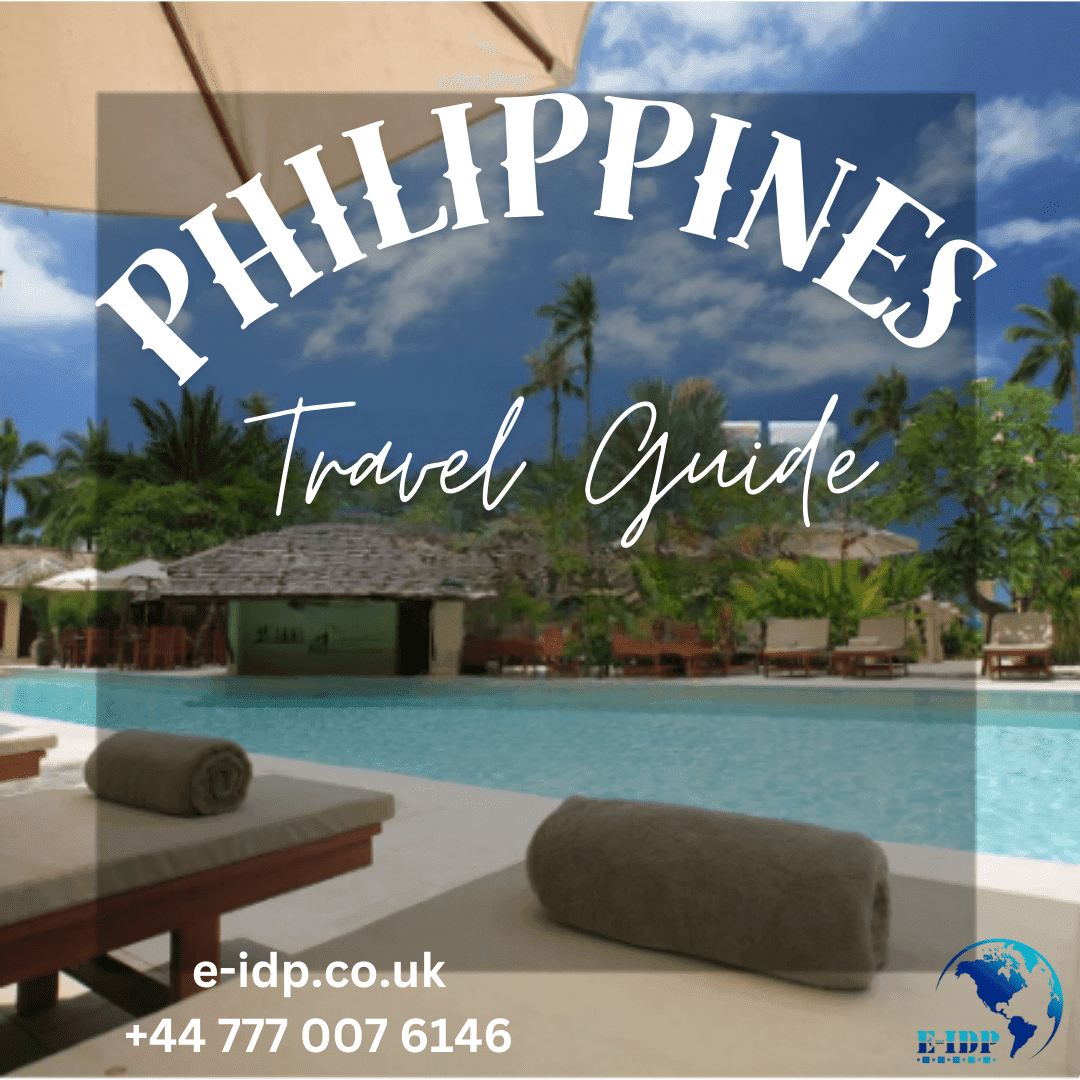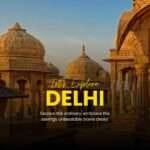Philippines Travel Guide, IDP apply online Philippines, International Driving Permit Philippines, International Driving licence Philippines, International Driving license Philippines
Philippines Travel Guide: Discover the Pearl of the Orient
The Philippines is a stunning archipelago in Southeast Asia composed of over 7,000 islands, offering an unmatched variety of tropical beaches, rich culture, and vibrant cities. Whether you’re seeking serene island getaways, historical landmarks, or adrenaline-pumping adventures, the Philippines has something for everyone. This comprehensive travel guide will help you make the most of your trip to this incredible country.
Best Time to Visit the Philippines
The Philippines has a tropical climate, which means it experiences warm weather year-round, but it is divided into two main seasons: the dry season (November to May) and the wet season (June to October). The best time to visit depends on what you want to experience.
- Dry Season (November to May): This is the peak travel period, with sunny days and minimal rainfall. Ideal for beach vacations and outdoor activities, it’s the perfect time to visit islands like Palawan, Boracay, and Cebu.
- Wet Season (June to October): While this is considered the off-peak season due to frequent rain and occasional typhoons, it can still be a good time to travel, especially if you want to avoid crowds and get lower rates on accommodations. Some regions, like Siargao, are popular during the wet season for activities such as surfing.
Top Destinations in the Philippines
1. Palawan
Palawan is often referred to as the “Last Frontier” of the Philippines. It’s home to some of the country’s most iconic landscapes and is frequently named the best island in the world. Palawan offers a variety of experiences for nature lovers, from exploring limestone cliffs and hidden lagoons to diving in crystal-clear waters.
- El Nido: Famous for its dramatic karst formations, hidden beaches, and lagoons. Island-hopping tours are a must to fully experience El Nido’s beauty.
- Coron: A diver’s paradise, Coron is known for its World War II wreck diving sites and vibrant coral reefs. Non-divers can enjoy Kayangan Lake, often called the cleanest lake in the Philippines.
- Puerto Princesa: Home to the Underground River, one of the New Seven Wonders of Nature. The river flows through an 8.2-kilometer limestone cave, which you can explore on a guided boat tour.
2. Boracay
Boracay is renowned for its powdery white sand and clear blue waters, making it the ultimate beach destination in the Philippines. Located in the central region of the country, Boracay offers a lively atmosphere with plenty of opportunities for water sports, nightlife, and relaxation.
- White Beach: Stretching over 4 kilometers, this iconic beach is perfect for sunbathing, swimming, and enjoying sunset views.
- Puka Beach: For a quieter experience, head to Puka Beach, located at the northern tip of the island. It’s less crowded and offers a peaceful atmosphere.
3. Cebu
Known as the Queen City of the South, Cebu is a major hub in the Philippines that offers both urban attractions and natural wonders. It’s a gateway to some of the best dive sites, waterfalls, and historical landmarks in the country.
- Kawasan Falls: Famous for its multi-layered waterfalls and turquoise waters, canyoneering at Kawasan Falls is an unforgettable adventure.
- Moalboal: This laid-back coastal town is known for its sardine run, where millions of sardines swim in dense formations close to the shore. Divers and snorkelers can also explore Pescador Island and spot sea turtles.
- Magellan’s Cross: A historical landmark in Cebu City, it commemorates the arrival of Portuguese explorer Ferdinand Magellan in 1521.
4. Siargao
Siargao, often referred to as the surfing capital of the Philippines, has become a top destination for adventure seekers and surfers alike. With its relaxed island vibe and stunning natural beauty, Siargao offers a mix of adrenaline-packed activities and quiet beach escapes.
- Cloud 9: One of the world’s top surfing spots, Cloud 9 attracts surfers from around the globe. Even if you’re not a surfer, watching the pros ride the waves is a thrilling experience.
- Sugba Lagoon: A serene spot for paddleboarding, swimming, or simply taking in the beauty of the lagoon’s emerald waters.
- Magpupungko Rock Pools: Natural tidal pools that reveal themselves during low tide, perfect for swimming and cliff jumping.
5. Bohol
Bohol is famous for its unique Chocolate Hills, centuries-old churches, and the tiny tarsier, one of the smallest primates in the world. This island offers a mix of natural beauty and cultural heritage.
- Chocolate Hills: These geological formations resemble chocolate mounds and change color with the seasons. You can view them from an observation deck or take an ATV ride through the hills.
- Tarsier Sanctuary: Get a chance to see the elusive Philippine tarsier, one of the world’s smallest primates, in a sanctuary that protects these endangered creatures.
- Loboc River Cruise: Enjoy a leisurely cruise along the Loboc River, where you can savor local cuisine while being entertained by traditional Filipino music and dance.
Cultural Insights and Etiquette
The Philippines is known for its warm hospitality and friendly locals. Filipinos are generally welcoming to tourists, and you’ll often hear the phrase “Mabuhay!” (meaning “long live” or “welcome”). Here are some key points to keep in mind when interacting with locals:
- Respect for Elders: Filipinos show deep respect for their elders, and it’s common to use phrases like “po” and “opo” when addressing older individuals.
- Bayanihan Spirit: The Bayanihan is a cultural tradition of community cooperation, especially in rural areas. Visitors will notice that people are always willing to help, whether it’s giving directions or offering a ride.
- Catholic Influence: The Philippines is predominantly Catholic, and religious festivals, such as Sinulog in Cebu and Ati-Atihan in Kalibo, are deeply intertwined with local culture. If you visit during one of these festivals, expect colorful parades, music, and a joyous atmosphere.
Getting Around the Philippines
Flights
With so many islands spread across the country, domestic flights are the quickest way to travel between regions. Major airlines like Philippine Airlines, Cebu Pacific, and AirAsia offer frequent flights between key cities such as Manila, Cebu, Davao, and other major destinations.
Ferries
Ferries are another common way to travel between islands. Companies like 2GO Travel offer ferry services between popular tourist spots like Manila, Cebu, and Boracay. Smaller, local boats are also available for short inter-island trips.
Public Transportation
- Jeepneys: These iconic, colorful vehicles are the most common form of transportation in cities and rural areas. Jeepneys follow specific routes, and fares are incredibly affordable. Don’t forget to hand your fare to the driver or fellow passengers.
- Tricycles: In rural areas or smaller towns, tricycles (motorbikes with sidecars) are a convenient and affordable way to get around. Always agree on the fare before starting your ride.
- Buses and Vans: For longer journeys, especially on larger islands like Luzon, Mindanao, and Cebu, buses and vans are widely available and offer an affordable means of transportation.
Filipino Cuisine: Must-Try Dishes
The Philippines boasts a diverse culinary scene influenced by Malay, Spanish, Chinese, and American cuisines. Some dishes you must try during your trip include:
- Adobo: A savory stew made with either chicken or pork, marinated in vinegar, soy sauce, and garlic. This dish is a national favorite.
- Sinigang: A sour tamarind-based soup, often made with pork or seafood and vegetables like water spinach, eggplant, and radish.
- Lechon: A whole roasted pig, often served at festivals and special occasions, with crispy skin and tender meat.
- Halo-Halo: A popular dessert made with shaved ice, sweetened beans, fruits, jellies, and ice cream, perfect for cooling off on a hot day.
Safety Tips for Travelers
The Philippines is generally a safe country to visit, but as with any destination, it’s essential to take basic precautions to ensure a smooth trip.
- Be aware of your surroundings in busy areas, particularly in cities like Manila, where petty theft can occur.
- Respect local customs and always ask for permission before taking photos of people, especially in rural communities.
- Stay informed about weather conditions if you’re traveling during the wet season, as typhoons can occasionally disrupt travel plans.
What you need to rent a car, and how to rent one
As a tourist, you’ll most likely be renting a car (more on that in a bit) for your road trip. Even so, there are certain requirements that you’ll have to check off before you get into it.
- You have to get an International Driver’s Permit. Apply for it online or head to the office — we prefer doing it in person because the queue is pretty short during off-peak hours, and you can get it done on the same day. It’ll cost S$20 and is valid for one year from the date of issue.
- A valid local driver’s license. international driving licence online
- You have to be at least 21 years of age and have held your local licence for a year. A surcharge may be imposed for drivers under the age of 25.
- A passport for identification .
- A credit card in the driver’s name.
How to obtain an international driving permit

The process of obtaining an international driving license directly from an office can be quite challenging and time-consuming. The payment methods involved can also be complex. Therefore, it is recommended to consider applying for an international driving license from IMTA. The application process only takes around 10 to 15 minutes, making it a more efficient option for getting your international driving permit Get Your Online Int’l Driving Permit for the United Kingdom
The necessary details required for the application of an International driving permit include:
– Full Name
– Email & Phone Number
– Current Address
– Place of Birth
– National Driver’s License Number
– National Driver’s License Issued Date & Expiry Date
– Picture of Driver’s License & Your Head Shot Photo for Your IDP
 Philippines Travel Guide, IDP apply online Philippines, International Driving Permit Philippines, International Driving licence Philippines, International Driving license Philippines, Philippines Travel Guide, IDP apply online Philippines, International Driving Permit Philippines, International Driving licence Philippines, International Driving license Philippines, Philippines Travel Guide, IDP apply online Philippines, International Driving Permit Philippines, International Driving licence Philippines, International Driving license Philippines, Philippines Travel Guide, IDP apply online Philippines, International Driving Permit Philippines, International Driving licence Philippines, International Driving license Philippines
Philippines Travel Guide, IDP apply online Philippines, International Driving Permit Philippines, International Driving licence Philippines, International Driving license Philippines, Philippines Travel Guide, IDP apply online Philippines, International Driving Permit Philippines, International Driving licence Philippines, International Driving license Philippines, Philippines Travel Guide, IDP apply online Philippines, International Driving Permit Philippines, International Driving licence Philippines, International Driving license Philippines, Philippines Travel Guide, IDP apply online Philippines, International Driving Permit Philippines, International Driving licence Philippines, International Driving license Philippines





